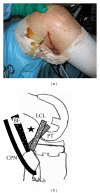Arthroscopic debridement of the posterior compartment of the knee after total knee arthroplasty
- PMID: 25202462
- PMCID: PMC4151537
- DOI: 10.1155/2014/568417
Arthroscopic debridement of the posterior compartment of the knee after total knee arthroplasty
Abstract
Arthroscopic debridement of the posterior compartment of the knee after total knee arthroplasty is difficult because it is tough to obtain intercondylar notch views. Herein, we performed arthroscopic debridement of the posterior compartment of an infected knee after total knee arthroplasty by using a transseptal portal in a 62-year-old woman with rheumatoid arthritis. Palpation of anatomical landmarks and posterior capsule protection are important for safe creation of a transseptal portal following to making 2 posterior portals.
Figures






Similar articles
-
Arthroscopic approach to the posterior compartment of the knee using a posterior transseptal portal.World J Orthop. 2015 Aug 18;6(7):505-12. doi: 10.5312/wjo.v6.i7.505. eCollection 2015 Aug 18. World J Orthop. 2015. PMID: 26301179 Free PMC article.
-
Neurovascular anatomic relationships to arthroscopic posterior and transseptal portals in different knee positions.Am J Sports Med. 2013 Jul;41(7):1559-64. doi: 10.1177/0363546513492704. Am J Sports Med. 2013. PMID: 23818438
-
Arthroscopic partial meniscectomy of a posteriorly flipped superior leaflet in a horizontal medial meniscus tear using a posterior transseptal portal.Orthopedics. 2012 Mar 7;35(3):e430-3. doi: 10.3928/01477447-20120222-37. Orthopedics. 2012. PMID: 22385458
-
Arthroscopic treatment of the degenerative knee in older athletes.Clin Sports Med. 1997 Jan;16(1):51-68. doi: 10.1016/s0278-5919(05)70007-7. Clin Sports Med. 1997. PMID: 9012561 Review.
-
[Anatomic features of posterior septum of knee joint and its application in posterior trans-septal portal for arthroscopic surgery].Zhongguo Xiu Fu Chong Jian Wai Ke Za Zhi. 2013 Feb;27(2):233-5. Zhongguo Xiu Fu Chong Jian Wai Ke Za Zhi. 2013. PMID: 23596695 Review. Chinese.
Cited by
-
Arthroscopic approach to the posterior compartment of the knee using a posterior transseptal portal.World J Orthop. 2015 Aug 18;6(7):505-12. doi: 10.5312/wjo.v6.i7.505. eCollection 2015 Aug 18. World J Orthop. 2015. PMID: 26301179 Free PMC article.
-
Arthroscopic treatment of total knee arthroplasty complications.EFORT Open Rev. 2019 Feb 13;4(2):33-43. doi: 10.1302/2058-5241.4.180035. eCollection 2019 Feb. EFORT Open Rev. 2019. PMID: 30931147 Free PMC article. Review.
References
-
- Flood JN, Kolarik DB. Arthroscopic irrigation and debridement of infected total knee arthroplasty: report of two cases. Arthroscopy. 1988;4(3):182–186. - PubMed
-
- Ilahi OA, Al-Habbal GA, Bocell JR, Tullos HS, Huo MH. Arthroscopic debridement of acute periprosthetic septic arthritis of the knee. Arthroscopy. 2005;21(3):303–306. - PubMed
-
- Polzhofer GK, Hassenpflug J, Petersen W. Arthroscopic treatment of septic arthritis in a patient with posterior stabilized total knee arthroplasty. Arthroscopy. 2004;20(3):311–313. - PubMed
-
- Waldman BJ, Hostin E, Mont MA, Hungerford DS. Infected total knee arthroplasty treated by arthroscopic irrigation and debridement. Journal of Arthroplasty. 2000;15(4):430–436. - PubMed
-
- Ahn J, Ha CW. Posterior trans-septal portal for arthroscopic surgery of the knee joint. Arthroscopy. 2000;16(7):774–779. - PubMed
LinkOut - more resources
Full Text Sources
Other Literature Sources

